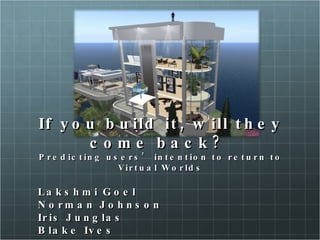Will They Come Back to VWs
- 1. If you build it, will they come back? Predicting users’ intention to return to Virtual Worlds Lakshmi Goel Norman Johnson Iris Junglas Blake Ives
- 2. Motivation Potential of Virtual Worlds Investment in Virtual Worlds Wane of initial patronage U of H Dell IBM U of H
- 3. Research Question What factors predict users’ intention to return to a place modeled in a Virtual World (VW) like Second Life?
- 5. Theoretical Background Interaction with others
- 6. Theoretical Background Interaction with space
- 7. Theoretical Background Interaction with artifacts
- 8. Theoretical Background Interaction with artifacts Interaction with space Interaction with others
- 9. Theoretical Background Aura Nimbus Focus Boundaries Spatial Model of Interaction (Benford et al. 1994)
- 10. Aura Click Click °ä±ôľ±ł¦°ě…
- 11. Nimbus/ Focus
- 12. Boundaries
- 13. Theoretical Background Awareness Attention Theory Awareness Who Where What (Davenport and Beck 2001)
- 14. Theoretical Background Awareness Attention Theory Awareness Who Where What (Davenport and Beck 2001) Meanings
- 15. Theoretical Background Experiences (Agarwal and Karahanna 2000)
- 16. Theoretical Background Experiences Place Attachment Theory (Milligram 1998)
- 17. Theoretical Background Meanings VW as Space VW as Place Experiences
- 18. Research Model Awareness Attention Theory Place Attachment Theory Spatial Model of Interaction
- 19. Research Method
- 20. An Island in Second Life
- 21. SIM AIS SMU Baylor U of H
- 24. Task
- 25. Sample 168 usable responses Undergraduate IS students
- 26. Results
- 27. Implications Research VW as a Place User experiences as predictor of Intentions State variables as predictors of CA Prediction of “Intention to Return to VW” Practice Design environments to leverage social, location, task awareness
- 29. Revision: Repositioning of the paper reduced references to TAM considerably Comment: Limit references to TAM
- 30. Revision Clear definition of CA is presented Similarities and differences between CA and Flow are discussed CA is characterized as being inherently pleasant (Agarwal and Karahanna 2000) Comment: Clarify Cognitive Absorption
- 31. Revision: A clear definition of social awareness, distinct from that of social presence, is presented Comment: Clarify Social Awareness
- 32. Revision A discussion of implications of the task, as well as the virtual world environment studied, is presented Limitations of the current study now include the nature of the task Comment: Reflect on boundaries of model and potential contingencies
- 33. Revision: The role of habit in formation of Intention to Return is discussed (Limayem and Hirt 2003; Limayem et al. 2007) Comment: Discuss the role of “habit”
- 34. Revision: Details are added to methodology section regarding the length of task, nature of participants, and control variables Comment: Clarify methodology
- 35. Earlier: Both PLS and AMOS used Revision: Analysis done exclusively in AMOS Comment: Use one data analysis technique
- 36. Thank You Reviewers, AE
- 37. If you build it, will they come back? Predicting users’ intention to return to Virtual Worlds Lakshmi Goel Norman Johnson Iris Junglas Blake Ives
- 38. Questions?
- 39. Extra şÝşÝߣs
- 40. Research Model Intention to Return: Idea that a user will come back, by way of the VW technology, to the “place” that is modeled in the VW. Cognitive Absorption: State of deep involvement that a user experiences as he or she performs an activity in the VW. Social Awareness: Perception one has that: (1) others are in the same space, and (2) that one can understand and interact with them in a social sense. Location Awareness: Perception one has about where in space he or she is by virtue of what objects are in that space and what activities are done in it. Task Awareness: Perception one has about what he or she is to do based on instructions, tools, or the actions of others in a shared given space.
- 41. Theoretical Background Aura: Mechanism by which the medium (audio, vision, or text) in the VW comes into being in relation to an object Focus: ability to delimit an observed object’s interest such that the more an object is within your focus, the more aware of it you are Nimbus: ability to represent an observed object’s projection toward you such that the more an object is said to be within your nimbus, the more aware it is of you Boundaries: divide space such that they provide mechanisms to mark territories, control movement and influence interactional properties of space Spatial Model of Interaction (Benford and Fahlen 1993; Benford et al. 1994)
- 42. Awareness-Attention Theory Concurrent input of informational cues: Awareness Individual engages in mental screening of cues: Cognitive process Assigns meanings to unfamiliar informational cues based on memory and prior experiences: Attention Leads to a state of Cognitive Absorption (Davenport and Beck 2001)
- 43. Place Attachment Theory Meaningful experiences Interactional past Interactional potential People will return to a place because of the interactional associations (Milligram 1998)
- 44. Results
- 45. Results
- 48. Revision: Focus on the awareness constructs is due to unique features of VWs SA: Many-to-many interactions through happenstance in virtual space LA: Contextual objects, boundaries, and virtual spaces TA: Virtual artifacts, textual, visual, haptic cues for task information Aura, Nimbus, Focus as properties of VWs Comment: Justify why three awareness constructs
- 49. Revision: This is beyond the scope of this study. We reiterate that our focus is “Intention to Return” rather than actual return Comment: For a reliable measure of “Intention to Return” test how many participants do actually return


















































